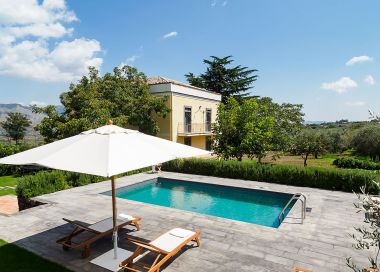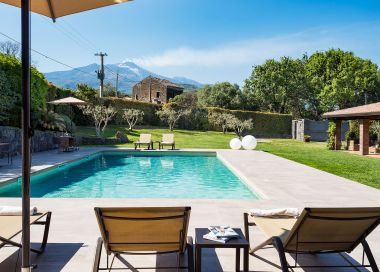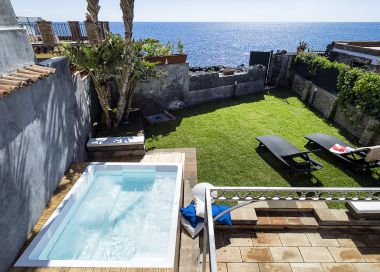Catania
Catania, the city at the foot of Etna, the highest active volcano in Europe
Catania is the second most important city in Sicily after the capital Palermo but considered the most important from a commercial and industrial perspective. The city was originally a settlement of the ancient Sicani people about which little is known. Around 729 B.C. the city was conquered by Greek colonisers and subsequently fell to various occupying powers which include the Romans, Byzantines, Normans and Svevi who constructed Castello Ursino. Subsequently under the Aragonese domination it was declared the capital of the Kingdom of Sicily in 1282 and remained so until the formation of the Kingdom of Italy. Today the city is located on the east coast of Sicily at the foot of the volcano Etna facing the Ionian Sea. It is surrounded by the vast plain of the volcano and by the nature reserve of the Simeto river, the most important in Sicily. An underground river (the Amenano) runs under the city. In the past, a short distance outside the western walls of the city, the Nicito lake could be found, however, the lake was covered by a lava flow in 1669. The position of the lake can be identified today by the street of the same name. Today the Amenano river is visible at the Acqua a Linzolu, a fountain made from white marble located between the Pescheria (fish market) and the Piazza del Duomo, and in the cellars of the Ostello Agorà. The surrounding landscape changed considerably during various eruptions of the volcano that took place between 1169 and 1381 which created the rocks to the north of the port and partially covered the old Porto Ulisse. This part of the coast is now called La Scogliera and includes the small beach of San Giovanni li Cuti. The area south of Castello Ursino (once right next to the sea) was created during the great lava flow of 1669 which encircled it and pushed it several kilometres towards the sea. The coastline south of the port was severely affected and the stretch of coastline now known as La Plaia, which is sandy, was created at this time.
Few traces of the Greek period remain in the city today, however, a larger number of Roman remains can still be seen such as the Roman Theatre (from the second century), the Odeon (from the third century), the Amphitheatre (from the second century), the Indirizzo Baths, the Rotonda Baths, the Achilliane Baths, various other bathing structures (in Piazza Sant’Antonio, Piazza Itria and Piazza Dante where a paved road has been uncovered and is partially visible today), the remains of an Aqueduct near Via Grassi and various buildings where funerals took place. The Cappella Bonajuto dates from the Byzantine period, the church of Sant’Agata al Carcere and Castello Ursino from the Svevi period, the church of Santa Maria del Gesù and the so-called Walls of Charles V from the Aragonese period. Rare examples of Sicilian Baroque architecture can be found in the churches, monasteries and palaces of Via dei Crociferi where the church of San Benedetto is located. Via Etnea is today considered the ‘living room’ of the city stretching across Catania from north to south, arriving at Piazza Università and 100 metres further on at Piazza Duomo where, in addition to the cathedral, the symbol of the city can be found: an elephant with its trunk pointing towards the sky. The street is lined with beautiful palaces, churches and basilicas and numerous elegant bars and restaurants. Catania is a rich and multi-faceted city with an artistic soul. Many painters, musicians and entertainers were born here. Another feature of Catania is its various markets and one of the best places to sample daily life in Catania is at the fish market (La Pescheria), always a mass of colours, sounds and smells. Another famous market is the market located in Piazza Carlo Alberto, commonly-known as the “Ferra o Luni” or “Fiera del Lunedi” because originally the market operated only on Mondays. In the same square on Sundays there is a large flea market. Another market open on Sundays sells bric-a-brac under the “marina” arches near to Villa Pacini. Another popular market takes place on Fridays in Piazza I Viceré in the district north of Barriera del Bosco. Catania also makes a good base from which to visit a large part of the eastern area of Sicily which includes numerous protected nature reserves such as the Etna National Park, the Alcantara River Nature Reserve and the nature reserve on the Simeto river.
Few traces of the Greek period remain in the city today, however, a larger number of Roman remains can still be seen such as the Roman Theatre (from the second century), the Odeon (from the third century), the Amphitheatre (from the second century), the Indirizzo Baths, the Rotonda Baths, the Achilliane Baths, various other bathing structures (in Piazza Sant’Antonio, Piazza Itria and Piazza Dante where a paved road has been uncovered and is partially visible today), the remains of an Aqueduct near Via Grassi and various buildings where funerals took place. The Cappella Bonajuto dates from the Byzantine period, the church of Sant’Agata al Carcere and Castello Ursino from the Svevi period, the church of Santa Maria del Gesù and the so-called Walls of Charles V from the Aragonese period. Rare examples of Sicilian Baroque architecture can be found in the churches, monasteries and palaces of Via dei Crociferi where the church of San Benedetto is located. Via Etnea is today considered the ‘living room’ of the city stretching across Catania from north to south, arriving at Piazza Università and 100 metres further on at Piazza Duomo where, in addition to the cathedral, the symbol of the city can be found: an elephant with its trunk pointing towards the sky. The street is lined with beautiful palaces, churches and basilicas and numerous elegant bars and restaurants. Catania is a rich and multi-faceted city with an artistic soul. Many painters, musicians and entertainers were born here. Another feature of Catania is its various markets and one of the best places to sample daily life in Catania is at the fish market (La Pescheria), always a mass of colours, sounds and smells. Another famous market is the market located in Piazza Carlo Alberto, commonly-known as the “Ferra o Luni” or “Fiera del Lunedi” because originally the market operated only on Mondays. In the same square on Sundays there is a large flea market. Another market open on Sundays sells bric-a-brac under the “marina” arches near to Villa Pacini. Another popular market takes place on Fridays in Piazza I Viceré in the district north of Barriera del Bosco. Catania also makes a good base from which to visit a large part of the eastern area of Sicily which includes numerous protected nature reserves such as the Etna National Park, the Alcantara River Nature Reserve and the nature reserve on the Simeto river.







